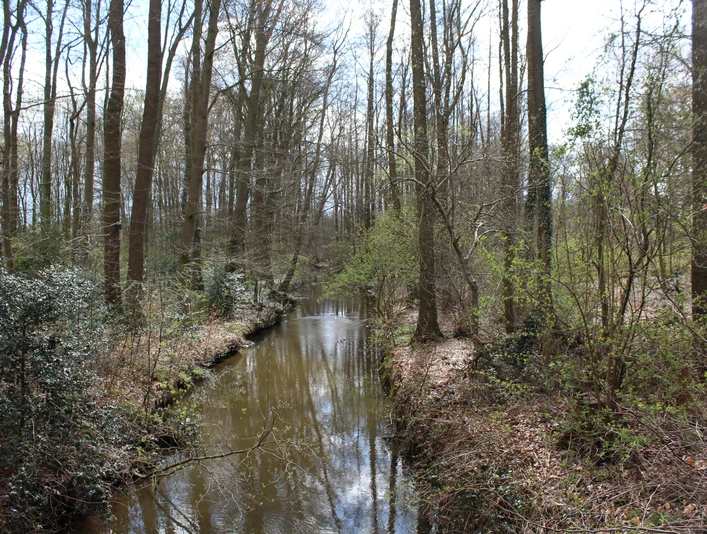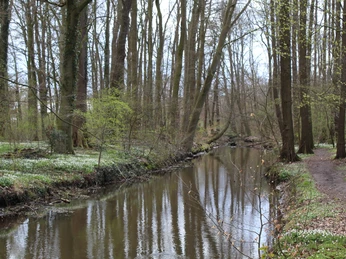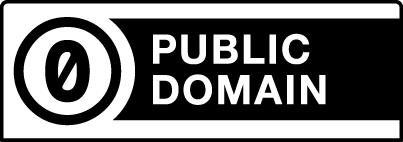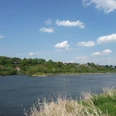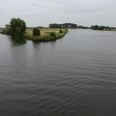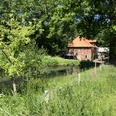This is a narrow piece of woodland on the Geestbach "Hache" stream, which extends north of the Sudweyhe watermill. The deciduous forest in the Kirchweyhe district, which is characterized by alders (Ellern!), beeches and oaks, is part of a landscape park created since the early 18th century.
In the northern section, i.e. between the small railway line completed in 1910 and the pedestrian bridge at the "1100 Years of Weyhe" monument, there was already a small grove around 1700. It belonged to the von Hademstorf family. They owned an estate at the Felicianus church and the Finterei estate in Sudweyhe, to which most of today's Ellernbruch belonged.
Only a meadow, which was located directly on today's street "Im Mühlengrunde", was part of the property of the large Sudweyhe estate, then owned by the head captain August Christian von Fabrice, as was the adjoining watermill. On 18th century plans, this meadow is called either "Kahlenbruch" or "Mühlenbruch". At the beginning of November 1750, it was planted with alder heathers "due to the poor grasses growing there". After August Christian von Fabrice had also acquired the Finterei estate at the end of 1750, he first had the Hache below the "Kahlenbruch" straightened. This was followed in November 1751 by the planting of an alder avenue leading to "Hademstorfs Holz". It was precisely these and the "Ellern" planted the year before that gave the woodland its later name.
The terrain was gradually afforested further. For example, at Easter 1766, the estate manager had oak trees planted on a small hill next to today's Waldstrasse. The plan was obviously to extend the landscape park to the Kirchweyher estate of the von Hademstorf family. The large estate, which was located directly next to the Felicinaus church, had been purchased in 1764 by Wilhelm August and Marianne Hypolithe von Schwicheldt, the new owners of the large Sudweyher estate. However, the northern section of the park was never extended.
The park belonging to the von Schwicheldt family was not open to the public, at least not until the early 20th century. During the First World War, Sudweyhe's primary school teacher Hermann Bauer noted in the local school chronicle: "In the village itself lies the manor house of the estate, surrounded by a magnificent park of venerable oaks and beeches. Shady paths, especially the path to the monument of 'tenderness', make the stay very pleasant; unfortunately, the inhabitants are not allowed to visit. Only very exceptional personalities receive permission from the estate inspector to enter the sanctuary. Entering the Ellernbruch is also not permitted. Warning signs everywhere: 'No entry', 'Pedestrians revocably permitted' and so on. In the interests of the general public, something like this is deeply regrettable; hopefully times will change."
Times have changed! At least access to the Ellernbruch was soon permitted. Walkers and cyclists use and enjoy the path through this part of the Weyher Hache valley.
In the northern section, i.e. between the small railway line completed in 1910 and the pedestrian bridge at the "1100 Years of Weyhe" monument, there was already a small grove around 1700. It belonged to the von Hademstorf family. They owned an estate at the Felicianus church and the Finterei estate in Sudweyhe, to which most of today's Ellernbruch belonged.
Only a meadow, which was located directly on today's street "Im Mühlengrunde", was part of the property of the large Sudweyhe estate, then owned by the head captain August Christian von Fabrice, as was the adjoining watermill. On 18th century plans, this meadow is called either "Kahlenbruch" or "Mühlenbruch". At the beginning of November 1750, it was planted with alder heathers "due to the poor grasses growing there". After August Christian von Fabrice had also acquired the Finterei estate at the end of 1750, he first had the Hache below the "Kahlenbruch" straightened. This was followed in November 1751 by the planting of an alder avenue leading to "Hademstorfs Holz". It was precisely these and the "Ellern" planted the year before that gave the woodland its later name.
The terrain was gradually afforested further. For example, at Easter 1766, the estate manager had oak trees planted on a small hill next to today's Waldstrasse. The plan was obviously to extend the landscape park to the Kirchweyher estate of the von Hademstorf family. The large estate, which was located directly next to the Felicinaus church, had been purchased in 1764 by Wilhelm August and Marianne Hypolithe von Schwicheldt, the new owners of the large Sudweyher estate. However, the northern section of the park was never extended.
The park belonging to the von Schwicheldt family was not open to the public, at least not until the early 20th century. During the First World War, Sudweyhe's primary school teacher Hermann Bauer noted in the local school chronicle: "In the village itself lies the manor house of the estate, surrounded by a magnificent park of venerable oaks and beeches. Shady paths, especially the path to the monument of 'tenderness', make the stay very pleasant; unfortunately, the inhabitants are not allowed to visit. Only very exceptional personalities receive permission from the estate inspector to enter the sanctuary. Entering the Ellernbruch is also not permitted. Warning signs everywhere: 'No entry', 'Pedestrians revocably permitted' and so on. In the interests of the general public, something like this is deeply regrettable; hopefully times will change."
Times have changed! At least access to the Ellernbruch was soon permitted. Walkers and cyclists use and enjoy the path through this part of the Weyher Hache valley.
Good to know
Payment methods
free of charge
Author
Mittelweser-Touristik GmbH
Lange Straße 18
31582 Nienburg/Weser
Organization
Mittelweser-Touristik GmbH
License (master data)
Mittelweser-Touristik GmbH
Nearby
